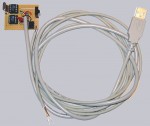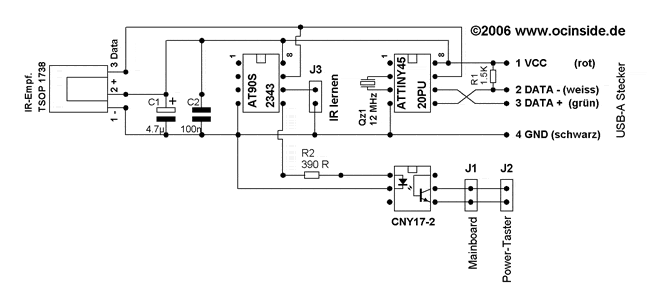
The function and the circuit diagram of the USB Ultra IR receiver
UPDATE: This Version 1.1 is now replaced by the new USB Ultra IR Version 2.0, to ensure the operation also on newer PCs with more recent motherboards.
The USB Ultra IR receiver functions …
First I would like to explain here briefly, what the Ultra IR receiver makes at all.
When the TSOP1738 receives a RC5 coded infrared signal, it gets on the one hand directly to pin 7 of the programmable AT90S2323-10 or the new ATtiny45-20PU Atmel IC.
This Atmel IC, is clocked in the circuit with a 12 MHz quartz (the older AT90S2323-10 IC is overclocked) and provides a communication between the Infrared receiver and the PC, so that this signal can being processed by infrared receiver programs like Girder.
The 1.5 K resistor is as Pullup resistor between the negative data line and the 5 V power supply of the USB connetor to stabilize the logical signal.
Who would like to insert an infrared control LED, can by the way simply solder a LED with a resistor between Data (Pin3) and +5 V of VCC (Pin2) of the TSOP1738.
The signal goes however not only to the PC, but also to the second AT90S2343 or the new ATtiny13V-10PU Atmel IC, which have to be programmed with a special firmware before and has the following function:
– If the Jumper J3 is put in, the AVR IC save the valid RC5 code of an infrared remote control in the integrated EEPROM to compare it. The desired key on the remote control for switching on and switching off the PC is thus programmed. As soon as a valid RC5 signal of the remote control arrives, the opto coupler is supplied with power …
– When the Jumper is then taken off, the small 8-bits AVR RISC processor compares all incoming signals with the stored signal of the EEPROM and if the two signals are equal, the opto coupler is supplied with power.
Unfortunately the AT90S2343 Atmel IC cannot be programmed any longer as simply as the AT90S2323 IC in the USB infrared receiver guidance, since Atmel changed some special Fuse bits which prevents a programming of the firmware with conventional ISP prommer (ISP = in system prommer). For this reason I program the firmware with a more complex Atmel programmer directly on the ICs and offer them programmed as kit in the Fanshop. Here I set also all fuse bits that this Atmel IC needs no external quartz or resonator.
The opto-coupler and the solution to switch the PC on and off …
After careful consideration and numerous tests I decided to pass the switching signal of the Atmel IC over a 390 ohms resistor to an opto coupler, which has the task, to connect its 2-pole output (pin 4 & pin 5), as soon as the input pins (pin 1 & pin 2) got the switching voltage. This output could be connected e.g. with a WoL (Wake on Lan) connector, where we can also get the 5 Volt power. However, then one would not have the ingenious advantage to additionally switch its PC off.
For this reason I decided for better solution, where the output of the opto coupler is connected directly with the PC power Button parallel to the power Button connection of the motherboard. The circuit get its necessary 5 V power supply over an USB cable, because current ATX Mainboards supplies the USB port also with power when the PC is switched off if this is activated by a Jumper (+5VSB) or in the BIOS. If this is not the case, or the PC has no necessary PowerOn feature, it’s possible to get the 5 Volt power over a small external 5 Volt regulated power supply unit. Alternatively it would be possible to get it from the ATX power supply connector directly. However a wrong wiring would forgive no errors, therefore I would not like to continue here with a detailed explanation.
It’s easy to check if the USB port gets power when the PC is switched off, with an optical Mouse at the USB port. Because the lighting of the optical scanning continues in this case if the PC is switched off. Of course it’s also possible to measure the voltage of the USB port. And who would like to vary a little bit, can use the WoL connection of the Mainboard.
Here is the circuit for the USB Ultra IR guide …
Here again the connection diagram with the AT90S2323-10
IC. Who like to use additional LEDs, can use this Circuit with LEDs.
On request I have also build another variant for the operation of the power AND the reset Button. Here is a link to the special POWER and RESET circuit. If you would like to build this, you can order e.g. the USB Ultra IR kit in combination with the normal Ultra IR kit and develop hereby the complete special reset & power circuit.


